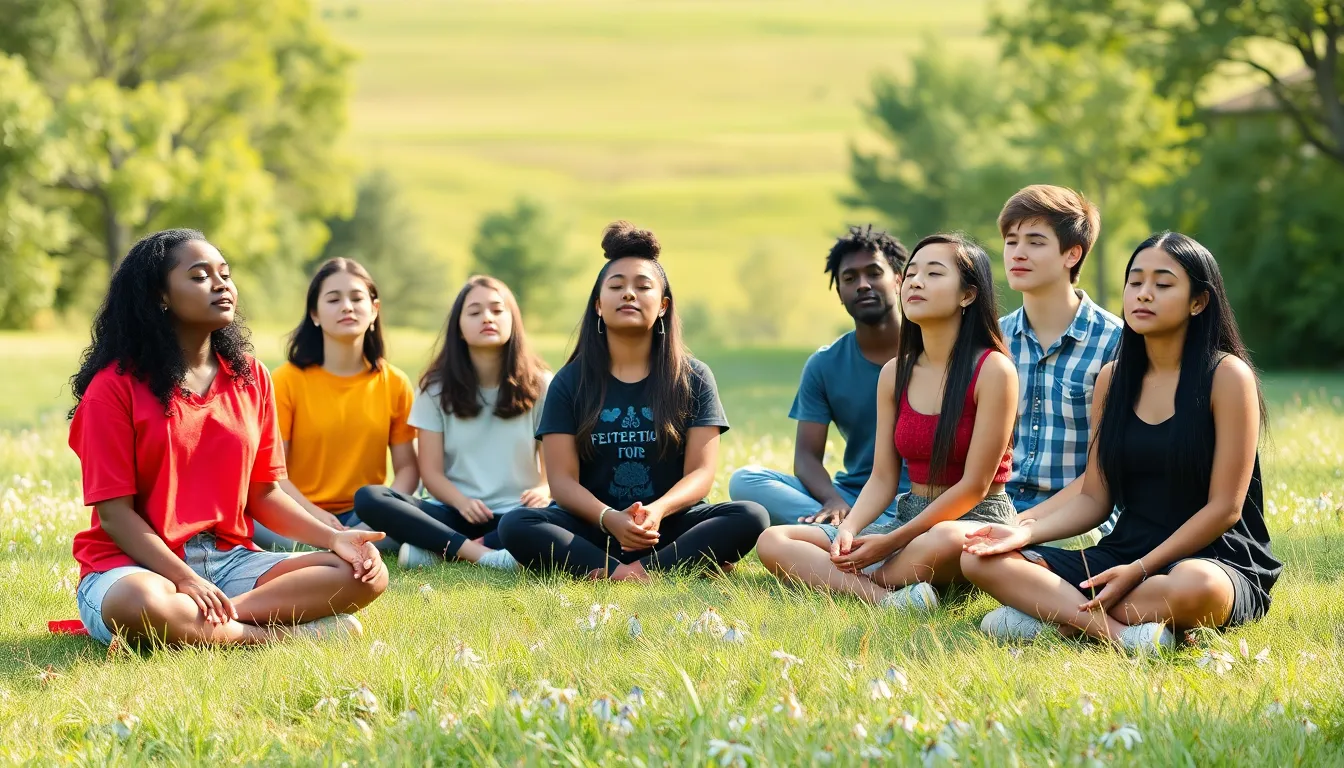Table of Contents
ToggleIn a world filled with TikTok dances and endless scrolling, finding a moment of peace can feel like searching for a unicorn. But guess what? Mindfulness isn’t just for yoga moms sipping green smoothies. It’s a superpower teens can harness to tackle stress, boost focus, and maybe even improve their grades—no cap!
Imagine a life where anxiety takes a backseat and clarity takes the wheel. With the right mindfulness exercises, teens can transform their chaotic days into a serene journey. Whether it’s a quick breathing exercise between classes or a mindful snack break, these simple practices can make a world of difference. So, let’s dive into the fun and effective ways to help teens cultivate mindfulness and unleash their inner zen master.
Overview of Teen Mindfulness Exercises
Teen mindfulness exercises focus on enhancing awareness and promoting emotional well-being. These exercises can transform daily routines into opportunities for reflection, peace, and personal growth. Breathing techniques, for instance, serve as one of the simplest methods. With just a few minutes of focused breathing, a teen can achieve greater clarity and reduce anxiety.
Mindful eating stands out as another effective practice. This exercise encourages teens to engage with their food, appreciating flavors and textures. By concentrating on meals, they cultivate a healthier relationship with food and develop an appreciation for their nourishment.
Guided imagery also proves beneficial. This technique involves visualizing calming scenarios, helping teens escape stressors temporarily. With regular practice, teens can learn to return to this mental space whenever needed, improving their ability to cope with challenges.
Movement-based exercises like yoga play a crucial role as well. Through yoga, teenagers learn to connect their physical bodies with their mental states. Practicing poses enhances flexibility while reducing tension, which often accompanies academic pressures.
Journaling introduces another valuable tool for mindfulness. Writing thoughts and feelings down allows teens to explore their emotions more deeply. This reflective practice encourages self-expression and clarity, enabling them to process their experiences.
Incorporating these mindfulness exercises into daily routines can profoundly influence teenagers. By dedicating time to these practices, they cultivate resilience and improve their overall mental health. Prioritizing mindfulness helps teens navigate life’s complexities with greater ease and confidence.
Benefits of Mindfulness for Teens

Mindfulness exercises offer various benefits for teens, including improved mental health and enhanced academic performance.
Mental Health Improvements
Mindfulness significantly reduces anxiety levels and promotes emotional regulation. Practicing mindfulness helps teens manage stress effectively, allowing for a calmer state of mind. Engaging in mindfulness activities can decrease symptoms of depression, fostering a more positive outlook. Studies show that consistent mindfulness practice increases self-awareness, aiding in the understanding of emotions. Strategies such as mindfulness meditation help teens develop coping mechanisms for challenging situations. Consequently, these improvements lead to a stronger resilience in facing daily life.
Academic Performance Boost
Mindfulness plays a vital role in improving focus and concentration. Techniques such as deep breathing can create a more conducive environment for studying. Enhanced attention spans mean that teens grasp concepts faster and retain information better. Evidence points to mindfulness training boosting overall academic performance, with higher grades reported in students who practice regularly. Creating a mindful routine can lead to more effective time management and organization skills. Academic confidence grows as teens feel more in control of their abilities and responsibilities.
Popular Teen Mindfulness Exercises
Teens can benefit greatly from various mindfulness exercises. These techniques promote emotional well-being and enhance overall awareness.
Breathing Techniques
Breathing techniques provide a simple way for teens to manage stress. Focusing on deep, rhythmic breaths helps calm the mind. One effective method involves taking a deep breath in for four counts, holding it for four counts, and exhaling slowly for six counts. Practicing this for a few minutes can significantly reduce anxiety during overwhelming situations. Engaging in these exercises regularly enhances self-awareness and promotes a sense of clarity.
Guided Imagery
Guided imagery serves as a powerful tool for relaxation. This exercise encourages teens to visualize calming scenes, such as a peaceful beach or tranquil forest. Imagining sensory details stimulates the mind, allowing for a complete mental escape from daily stressors. A structured session might involve listening to a calming voice guiding them through the imagery. Consistent practice can lead to improved emotional regulation and resilience when facing challenges.
Journaling Practices
Journaling practices offer teens a structured way to express their thoughts and feelings. Writing in a journal promotes self-reflection and emotional exploration. A popular technique includes responding to specific prompts, such as “What made me happy today?” or “What challenges did I face?”. This practice helps clarify thoughts and fosters emotional growth. Over time, journaling can enhance self-awareness and improve coping strategies in stressful situations.
How to Incorporate Mindfulness into Daily Life
Incorporating mindfulness into daily routines can significantly enhance a teen’s well-being. Consistency plays a vital role in cultivating this practice.
Setting a Routine
Establishing a regular mindfulness routine creates stability. Morning mindfulness can start the day with focus. Evening practices help unwind and reflect on the day’s events. Using specific times, like right after waking up or before bed, can make mindfulness a habit. Setting reminders on phone alerts can serve as perfect prompts. A five-minute check-in through breathing exercises provides valuable space for self-awareness. Creating a peaceful environment, free of distractions, enhances the practice’s effectiveness. Engaging in mindfulness activities such as journaling or guided meditation during consistent time slots reinforces the commitment.
Group Activities
Group mindfulness activities can enhance motivation and foster connection among peers. Participating in sessions with friends can make the experience more enjoyable. Schools can offer mindfulness clubs or workshops, providing structured time for practice. Group meditations or yoga sessions create a supportive environment, allowing teens to share their experiences. Incorporating mindfulness games can also capture interest and make the process interactive. Engaging in discussions about mindfulness topics can promote deeper understanding. Activities in nature, like hiking or outdoor yoga, can connect teens with their surroundings while fostering mindfulness. Collaboration with peers encourages accountability, making it easier to stick with the practice together.
Mindfulness can be a transformative practice for teens navigating the complexities of modern life. By integrating simple exercises into their daily routines, they can cultivate emotional resilience and enhance their overall well-being. Whether through breathing techniques, mindful eating, or movement practices like yoga, these tools empower teens to manage stress and improve focus.
Establishing a consistent mindfulness routine not only fosters personal growth but also creates a supportive community among peers. As teens embrace these practices, they’ll find themselves better equipped to face challenges with confidence and clarity. Prioritizing mindfulness can lead to lasting benefits in both mental health and academic performance, paving the way for a more balanced and fulfilling life.







